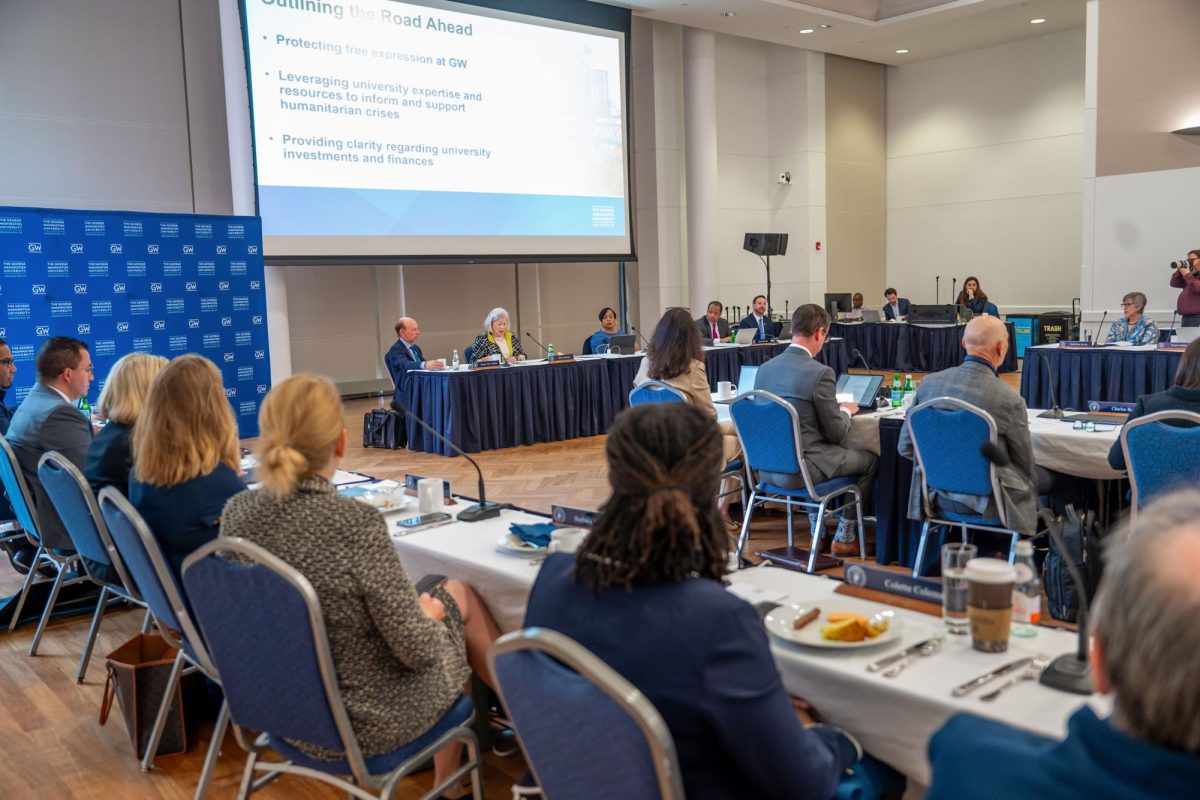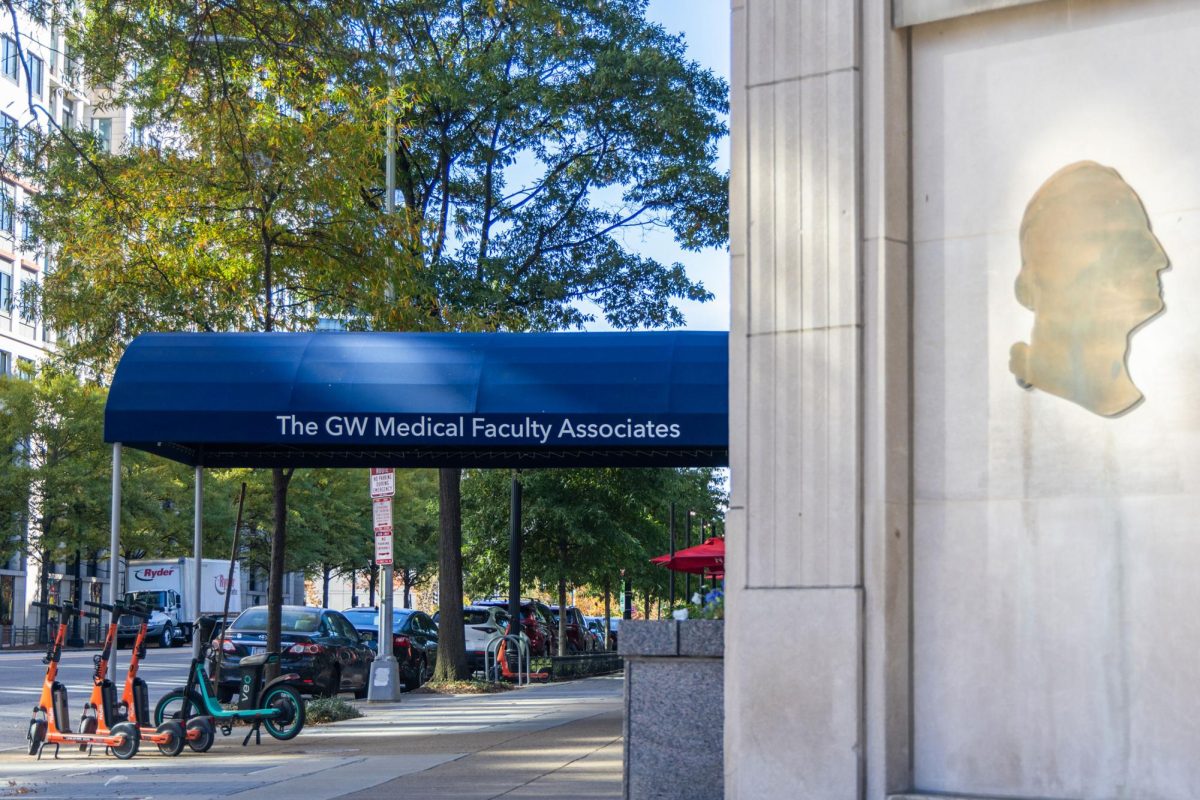GW’s first-year student retention rate bounced back this academic year after dropping following the onset of the COVID-19 pandemic in 2020, according to the Annual Core Indicators Report presented at the Faculty Senate meeting Friday.
Provost Chris Bracey said GW retained 90.74 percent of the current sophomore class who started to attend GW during the last academic year conducted entirely online during the pandemic, signaling students were eager to come to campus when in-person operations resumed. The freshmen retention rate fell to 88 percent in 2020 for the freshmen – currently juniors – who started attending GW in fall 2019 and couldn’t return to campus for their sophomore year during the height of the pandemic.
Bracey, who presented the annual core indicators report, said officials now aim to further boost the freshmen retention rate to 94 percent for future classes, in line with the typical performance of the top 50 colleges nationwide.
“Our aspiration is to attract students of the highest quality and caliber because those are the ones who are training to be those future leaders,” Bracey said.
He added that GW’s four-year graduation rate has continued trending upward, with the Class of 2021 reaching at least a 20-year high of 79.2 percent.
Bracey cited the graduation rate as one of the most crucial metrics that officials track because it reflects the success of GW’s entire academic enterprise. He said the caliber of faculty, academic resources, libraries and GW’s cost of attendance all contribute to the metric.
“It encapsulates all the work and resources we expend to support student success,” Bracey said.
He added that graduation rates can also improve with more financial aid, citing increases following the 2008 economic recession when students were provided with larger financial packages.
Bracey’s report also included data on faculty demographics, including tenure status, salary and diversity.
The number of faculty members who are tenured or on the tenure track has steadily declined since 2015, according to the report.
Bracey said the percentage of regular active faculty members who are tenured or on a tenure track dropped from 74.1 percent in 2020 to 73.5 percent in 2021 and has not hit the 75 percent minimum that is required by the Faculty Code since 2018. He said the figure declined because of difficulty replacing faculty following the hiring freeze instituted in March 2020 to mitigate the financial impact of the pandemic. The freeze was later lifted this past summer.
“We have turned the corner, however, and I’m confident that we’ll see the beginning of an upward trend with next year’s data and see the reestablishment of our faculty codes recommended ratios in the out-years,” Bracey said.
Bracey said the Board of Trustees approved a request this past summer to authorize 44 new tenure track searches and to reinstate the seven tenure-track searches that were previously placed on hold during the pandemic.
The report states the percentage of tenured or tenure-track faculty increased in the Columbian College of Arts and Sciences, Milken Institute School of Public Health, School of Medicine and Health Sciences and School of Nursing during the past 10 years. The report also states that in the same period, the percentage of tenured or tenure-track faculty decreased in the Elliott School of International Affairs, Graduate School of Education and Human Development, School of Business and GW Law.
“So the bottom line here is that additional investment in faculty, particularly tenured and tenure-track faculty, is warranted to return us to the levels that one might expect from a preeminent academic institution,” Bracey said.
Bracey said the University is working to close the 7.2 percent gap between male and female full-time faculty members but has “lost a little bit of ground” because of the pandemic. The presentation states that the number of female, full-time faculty members decreased from 623 to 604 this year, which Bracey said was likely caused by an uneven division of household labor during the pandemic.
“As you might imagine, this was due to exogenous factors related to family allocation of responsibilities, particularly with their young children who are forced out of daycare or doing remote schooling,” Bracey said. “This gendered phenomenon was well documented in the press and affected the University as it affected most employment sectors.”
Bracey said he is concerned that the percent change of underrepresented minority, full-time faculty members remained “largely flat” during the past decade. He said there was a 0.7 percent drop in the number of underrepresented minority faculty members during the pandemic, and the diversity program review team will examine the decline and make recommendations on how to address it.
CCAS officials launched the Inclusive Excellence Initiative last year and authorized a search for a dozen new hires to increase faculty diversity.
“I’ve made clear that we want schools and departments assembling very diverse candidate pools, and I want them redoubling their efforts to attract qualified women and minority candidates,” Bracey said.
Bracey said the average salary for full professors surpassed Northeastern University in 2021 to rank fifth among the University’s peer schools, despite a 0.9 percent decrease in GW’s average salary last year. He said Georgetown University remains GW’s main competitor as their average salary for full professors was $213,000, while GW’s was $186,000 in 2021.











